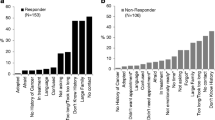Abstract
The aim of this study was to describe 2 years cancer survivors’ perception of the cancer risk running in their family, and to describe how frequently these survivors recommended cancer screening to their relatives. A national cross-sectional survey was launched by the French Ministry of Health to investigate the living conditions of adult cancer patients 2 years after cancer diagnosis. Among the 13,923 patients identified, 6,957 were eligible to participate in this study and 4460 (64.1%) answered the questionnaire administered by telephone. One participant out of every two (50.8%) reported that they thought their relatives’ risk of cancer was greater than that of the relatives of unaffected persons. Higher percentages were recorded among breast and colorectal cancer patients (65 and 65.1%, respectively), and lower percentages among those with lung and hematological cancer (34.9 and 28.4%, respectively). Overall, 61.1% of the participants had already advised relatives to undergo cancer screening and 10.4% planned to do so. Eighty-one percent of the participants with breast cancer and 76.3% of those with colorectal cancer said they had advised relatives to undergo screening. Lower percentages were obtained among patients with urinary tract (41.7%) and hematological malignancies (27.1%). Although patients’ perceptions tend to fit the latest data on the frequency of cancer germline mutations, physicians should help their patients to convey more accurate advice to their families. If survivors were better informed, they could play a critical role by conveying relevant and sound risk reduction messages to their relatives.
Similar content being viewed by others
References
Guilbert P Peretti-Watel, P, Beck F, Gautier A (2005) Ce que la population pense du cancer. Baromètre cancer eds INPES 31–52
Ricker CN, Hiyama S, Fuentes S, Feldman N, Kumar V, Uman GC, et al. (2007) Beliefs and interest in cancer risk in an underserved Latino cohort. Prev Med 44(3):241–5. Available from http://www.ncbi.nlm.nih.gov/entrez/query.fcgi?cmd=Retrieve&db=PubMed&dopt=Citation&list_uids=17027932
Redeker C, Wardle J, Wilder D, Hiom S, Miles A (2009) The launch of Cancer Research UK’s ‘Reduce the Risk’ campaign: baseline measurements of public awareness of cancer risk factors in 2004. Eur J Cancer 45(5):827–36. Available from http://www.ncbi.nlm.nih.gov/entrez/query.fcgi?cmd=Retrieve&db=PubMed&dopt=Citation&list_uids=19054666
Eisinger F, Tarpin C, Huiart L, Horsman D, Rabayrol L, Didelot R, et al (2005) Behavioral and economic impact of a familial history of cancers. Fam Cancer 4(4):307–11. Available from http://www.ncbi.nlm.nih.gov/entrez/query.fcgi?cmd=Retrieve&db=PubMed&dopt=Citation&list_uids=16341808
Croyle R (1995) Psychosocial effects of screening for disease prevention and detection. Oxford University Press, Oxford
Le Corroller-Soriano A, Malavolti L, Mermilliod C (2008) La vie deux ans après le diagnostic de cancer. Paris: La Documentation française
Andersen MR, Smith R, Meischke H, Bowen D, Urban N (2003) Breast cancer worry and mammography use by women with and without a family history in a population-based sample. Cancer Epidemiol Biomarkers Prev 12(4):314–20. Available from http://www.ncbi.nlm.nih.gov/entrez/query.fcgi?cmd=Retrieve&db=PubMed&dopt=Citation&list_uids=12692105
Chapple A, Ziebland S, Hewitson P, McPherson A (2008) What affects the uptake of screening for bowel cancer using a faecal occult blood test (FOBt): A qualitative study. Soc Sci Med 66(12):2425–35. Available from < Go to ISI > ://000256934800004
Eisinger F (2008) Genetic testing for familial cancer. The French National Report (year 2003). Commun Genet 11(1):63–7. Available from http://www.ncbi.nlm.nih.gov/entrez/query.fcgi?cmd=Retrieve&db=PubMed&dopt=Citation&list_uids=18196919
Foulkes WD (2008) Inherited susceptibility to common cancers. N Engl J Med 359(20):2143–53. Available from http://www.ncbi.nlm.nih.gov/entrez/query.fcgi?cmd=Retrieve&db=PubMed&dopt=Citation&list_uids=19005198
Risch HA, McLaughlin JR, Cole DE, Rosen B, Bradley L, Kwan E, et al (2001) Prevalence and penetrance of germline BRCA1 and BRCA2 mutations in a population series of 649 women with ovarian cancer. Am J Hum Genet 68(3):700–10. Available from http://www.ncbi.nlm.nih.gov/entrez/query.fcgi?cmd=Retrieve&db=PubMed&dopt=Citation&list_uids=11179017
Lamberti C, Mangold E, Pagenstecher C, Jungck M, Schwering D, Bollmann M, et al. (2006) Frequency of hereditary non-polyposis colorectal cancer among unselected patients with colorectal cancer in Germany. Digestion 74(1):58–67. Available from http://www.ncbi.nlm.nih.gov/entrez/query.fcgi?cmd=Retrieve&db=PubMed&dopt=Citation&list_uids=17095871
Schofield L, Watson N, Grieu F, Li WQ, Zeps N, Harvey J, et al. (2009) Population-based detection of Lynch syndrome in young colorectal cancer patients using microsatellite instability as the initial test. Int J Cancer 124(5):1097–102. Available from http://www.ncbi.nlm.nih.gov/entrez/query.fcgi?cmd=Retrieve&db=PubMed&dopt=Citation&list_uids=19072991
Ramus SJ, Gayther SA (2009) The contribution of BRCA1 and BRCA2 to ovarian cancer. Mol Oncol 3(2):138–50. Available from http://www.ncbi.nlm.nih.gov/entrez/query.fcgi?cmd=Retrieve&db=PubMed&dopt=Citation&list_uids=19383375
Insinga RP, Liaw KL, Johnson LG, Madeleine MM (2008) A systematic review of the prevalence and attribution of human papillomavirus types among cervical, vaginal, and vulvar precancers and cancers in the United States. Cancer Epidemiol Biomarkers Prev 17(7):1611–22. Available from http://www.ncbi.nlm.nih.gov/entrez/query.fcgi?cmd=Retrieve&db=PubMed&dopt=Citation&list_uids=18628412
Eisinger F, Sobol H, Serin D, Whorton JC (1998) Hereditary breast cancer, circa 1750. Lancet 351(9112):1366. Available from http://www.ncbi.nlm.nih.gov/entrez/query.fcgi?cmd=Retrieve&db=PubMed&dopt=Citation&list_uids=9643838
Johnson TP, O’Rourke DP, Burris JE, Warnecke RB (2005) An investigation of the effects of social desirability on the validity of self-reports of cancer screening behaviors. Med Care 43(6):565–73. Available from http://www.ncbi.nlm.nih.gov/entrez/query.fcgi?cmd=Retrieve&db=PubMed&dopt=Citation&list_uids=15908851
Kurz-Milcke E, Gigerenzer G, Martignon L (2008) Transparency in risk communication: graphical and analog tools. Ann N Y Acad Sci 1128:18–28. Available from http://www.ncbi.nlm.nih.gov/entrez/query.fcgi?cmd=Retrieve&db=PubMed&dopt=Citation&list_uids=18469211
Royak-Schaler R, Blocker DE, Yali AM, Bynoe M, Briant KJ, Smith S (2004) Breast and colorectal cancer risk communication approaches with low-income African-American and Hispanic women: implications for healthcare providers. J Natl Med Assoc 96(5):598–608. Available from http://www.ncbi.nlm.nih.gov/entrez/query.fcgi?cmd=Retrieve&db=PubMed&dopt=Citation&list_uids=15160974
Acknowledgments
The design and collection of the survey was supported by the research department of the French ministry of health (DREES), the three major French health care reimbursement offices (CNAMTS, CCMSA and RSI) and a cancer patients’ association (La Ligue Nationale Contre le Cancer).
Author information
Authors and Affiliations
Corresponding author
Rights and permissions
About this article
Cite this article
Eisinger, F., Bouhnik, A.D., Malavolti, L. et al. Cancer survivors: familial risk perception and management advice given to their relatives. Familial Cancer 10, 147–155 (2011). https://doi.org/10.1007/s10689-010-9390-1
Published:
Issue Date:
DOI: https://doi.org/10.1007/s10689-010-9390-1




